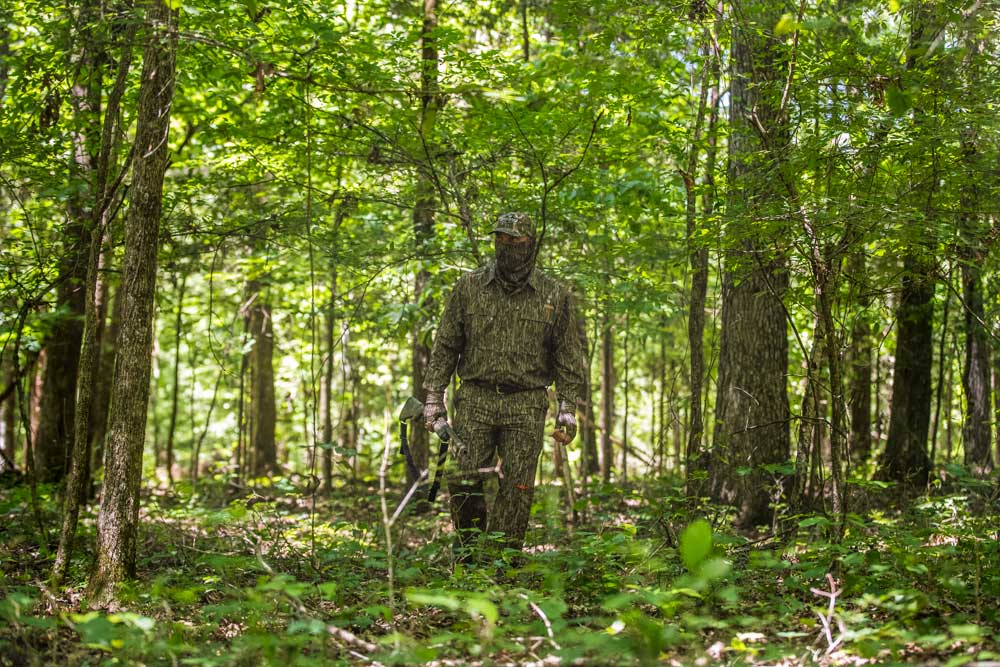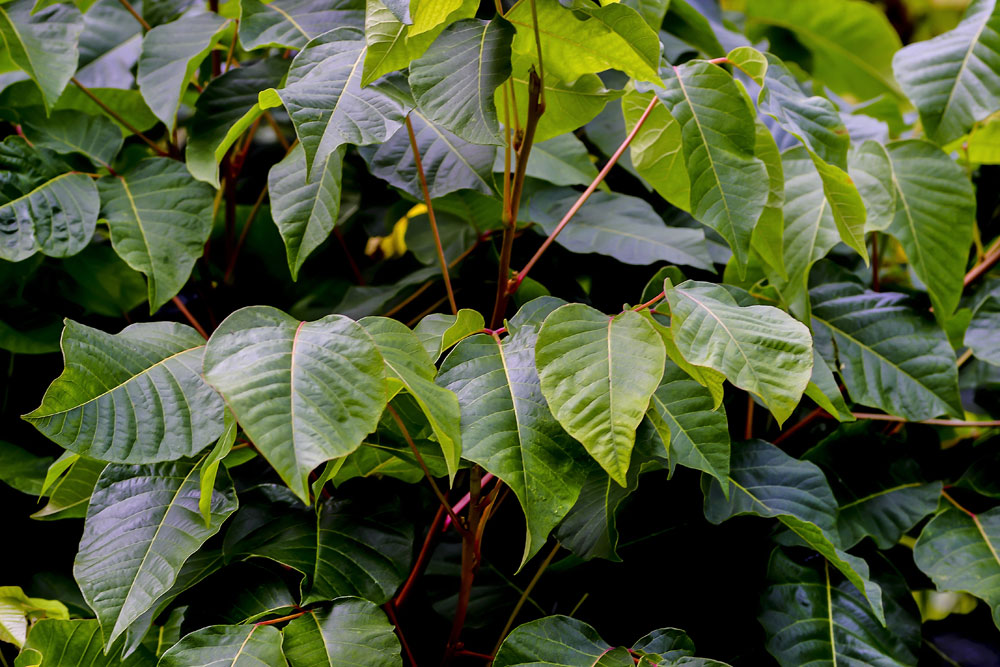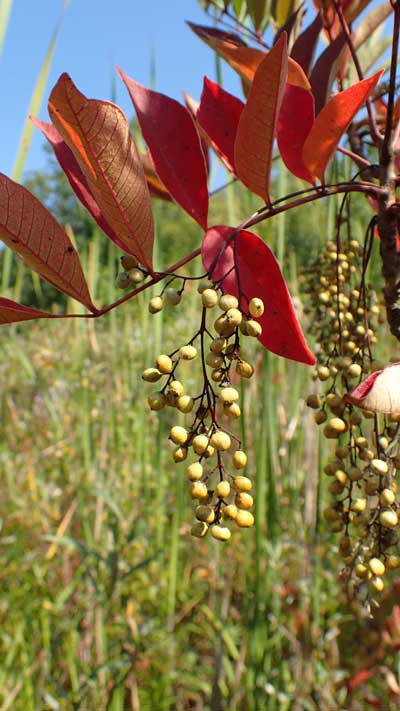Identifying poisonous plants is on any woodsman's mind or at the top of the family camping list. To identify poisonous plants, we have heard for years, “Leaves of three, let it be.” This is great advice for poison ivy and poison oak, but this advice will get you a bad rash from poison sumac. What does poison sumac look like, you ask? Let’s look at a few ways to identify and treat poison sumac.

Spring and Summer Leaves
The plant itself is considered a shrub, but many would call it a small tree. If you’re a botanist, you describe the leaves of poison sumac as pinnate. In layman’s terms that means it looks a little like a feather. The leaves have a stem that runs down the middle with leaves on either side of the stem. There is a single leaf at the end of the stem. In the spring and summer, the leaves are green.
Unfortunately, these are the types of stems and leaves that kids love to play with. They grab the stem with one hand and pull the leaves off with the other. Because of this, kids often end up with a rash on their hands and arms.
Fall Leaves
The leaves in the fall are beautiful and can be yellow and pink, red and pink or red, pink and yellow. In late fall, the leaves can become a brilliant red color that is much like that of a red maple tree. In the fall, many well-meaning nature lovers often get too close to poison sumac and end up with a nasty rash.
Even those raking and bagging leaves in the fall can get a rash from nearby poison sumac. This is especially frustrating when the leaves blow in from another area. You may not think to check for poison sumac leaves because the poisonous plant does not grow in your yard. It is still possible to get a nasty rash, even from a plant growing hundreds of yards away.
The Poison Sumac Stem
We have mentioned that poison sumac leaves are beautiful in the spring, summer and fall. The problem is, there are many shrubs and small trees with beautiful leaves. Take special note of the red stem. The red stem is unique to the poisonous variety of sumac. Non-poisonous sumac does not have a red stem. The stem runs between the leaves that are on either side with a single leaf at the end. The stem is hard to identify later in the year as it turns to a gray/brown color, much like the shrub’s bark. Take note of the red stem and remove that plant when you can. Until then, alert others to avoid contact with the poisonous plant.

Spring and Summer Berries
Both the poisonous and non-poisonous varieties of sumac have berries, but poisonous berries are unique to poison sumac. They are an oddly shaped berry that grows in loose clusters. The poison sumac berries have an irregular shape and each berry looks like it has been squashed. You may see birds eating the poison sumac berries with no side effects, but don’t be fooled as they are poisonous to humans. Of course, humans can’t eat the berry, but even touching it will cause a rash.
Fall Berries
Much like poison ivy, the color of poison sumac’s berry turns an off-white color in the fall. You should beware of plants with white berries in the fall. Many outdoorsmen notice birds and animals eating the berries with no problem. Even in the fall, the berries will still give humans a nasty rash.
If you decide to remove poison sumac from your property this fall, you will still need to take precautions to avoid contact with the poisonous plant. Even in the fall, the urushiol oil is present and will give you a nasty rash.
The Rash
Many have a hard time believing poison sumac gave them a rash when it has no leaves on the shrub. Even in the winter, poison sumac can give you a rash. Urushiol is the poisonous oil that poison sumac uses to defend itself. When you come in contact with any part of the plant, the urushiol oil is transferred to your skin. Your skin will absorb the oil, and your body will react to it 24 to 72 hours later as the rash starts.
The poison sumac rash looks like streaky patches of red blisters. The rash itself is not contagious but, if the urushiol oil is still on your clothes, dog or backpack, it can still give you a rash. Once you get the rash, you can have it for up to three weeks.
After the Rash
Once you know you have come in contact with poison sumac, you need to change clothes. Be careful removing your clothes and shoes, as they could still have the poison oil on them. Next, wash the exposed area with soap and warm water. If there is no water around, alcohol wipes will remove the urushiol oil. Try to keep the suspect area clean and dry.
Keep in mind that pets and garden tools may have oil on them as well. Your pet’s fur will typically prevent it from getting the rash, but if you come in contact with a pet that still has oil on its coat, it can cause a rash. It’s best to clean the tools and bathe your pet while wearing gloves.
Even if your kids were not in the woods, they can come in contact with poison sumac from your pets. If you notice your kids scratching or with a rash, it could be poison sumac exposure from your pet. It can be hard to do, but keep them from rubbing their eyes. Poison sumac can be exceptionally irritating when it’s around their eyes. It’s often best to have a pediatrician treat a poison sumac rash as soon as possible.

Home Remedies
Over-the-counter medicine will not remove or stop the rash, but it can make it more tolerable. Once you notice the rash, wash it with a degreasing dish soap or rubbing alcohol. Hopefully, you can remove the urushiol oil before the rash spreads. Calamine lotion, hydrocortisone and Benadryl can help with the itch. Try not to scratch. It can cause an infection and even leave scars. If it gets too bad, an oatmeal or baking soda bath can help. Don’t be surprised if you have to try all of this for some relief.
It’s Time for the Doctor
It seems like one person can come in contact with poison sumac and walk away with a light rash that goes away in a day or two. Another person seems to be hyper-allergic to it and ends up with a severe rash and a body covered in blisters. If you feel lightheaded and/or are having trouble breathing after contact with poison sumac, call 911 right away.
If at any time you have severe reactions in addition to the rash, like shortness of breath, upset stomach or fever, the rash site becomes extremely sensitive to the touch or your lymph nodes begin to swell, it’s time to head to the emergency room.
If you fight the rash with over-the-counter medicine and it seems like it is still spreading, it is a sign you are losing the fight. Once the rash is widespread or close to your eyes, it’s time to see the doctor.
Enjoy from a Distance
Both the poisonous and non-poisonous varieties of sumac are beautiful. Now that you know how irritating and downright dangerous poison sumac can be, it’s best to admire it from a long distance. If you accidentally get into it, you now know how to treat it and, hopefully, prevent it from becoming serious.































